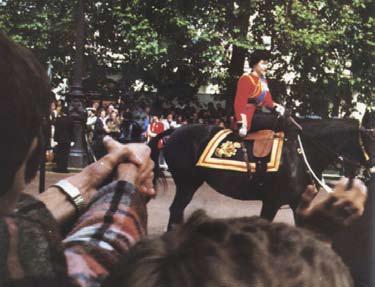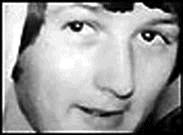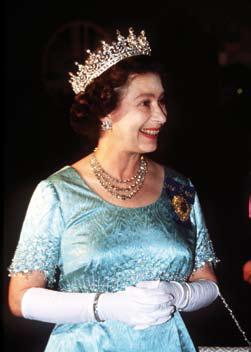Assassination: The Royal Family's 1000-Year Curse (63 page)
Read Assassination: The Royal Family's 1000-Year Curse Online
Authors: David Maislish
Tags: #Europe, #Biography & Autobiography, #Royalty, #Great Britain, #History

The royal train was heading for Orange, where the Queen and Prince Philip were to spend the night. Two hours out from Sydney, going through a winding cutting just before Lithgow, the train struck the log. Fortunately, the train was travelling very slowly, far slower than expected. So, instead of toppling off the track and into the embankment, the engine continued with the log trapped under its front wheels. It still took over 700 yards before the train came to a complete halt. The story is that the Queen was unaware of the incident, and the embarrassed authorities hushed the matter up.
In Britain, the Seventies was a time of increased political awareness, protest, terrorism and completion of the cycle of independence for nearly all colonies as the country looked towards Europe. In 1970, the Conservatives returned to power with Edward Heath as Prime Minister, 1971 saw decimalisation of the currency and measurements and the death of the Duke of Windsor (leaving no children, so even without the abdication Elizabeth would have succeeded as his niece); and in 1973, the United Kingdom joined the European Economic Community. In 1974, Labour led by Harold Wilson won the election, Wilson retiring in favour of James Callaghan in 1976; then the Conservatives took over in 1979 under Margaret Thatcher. The entire decade was marked by constant violence in Northern Ireland and IRA bombings in England, as well as the assassination of Earl Mountbatten.
The Trooping the Colour ceremony repeats the practice begun in the seventeenth century of parading in front of infantry regiments their colours or flags before battle so that the soldiers would recognise the flag, either to follow it in attack or to head for it as a rallying point. The Royal Artillery carries its colours on its guns, the rifle regiments on their drums, so they do not troop colours. For over 200 years, the ceremony has taken place in London on the monarch’s official birthday (a date chosen to coincide with the probability of fine weather) when one of the five Foot Guards regiments troops its colours in the presence of the sovereign.
On 13th June 1981, the annual ceremony began. Seventeenyear-old Marcus Sarjeant joined the crowds, standing at the junction of the Mall and Horseguards Avenue. As the Queen rode by on her horse, Sarjeant drew a pistol and fired six shots. The Queen’s horse was startled, but the Queen kept it under control. The shots were blanks. Sarjeant was arrested and taken away, saying that he wanted to be famous.
Sarjeant had been a military fanatic at school, and was fascinated by assassinations. He had left the Royal Marines after three months, after which he tried to enlist in the army, quitting after two days of the induction course. Following that, he failed in his attempts to join the police force and the fire service. He later became a member of an anti-royalist group. A note found in his home, where he lived with his mother, read: “I am going to stun and mystify the world. I will become the most famous teenager in the world.”
 Marcus Sarjeant aiming at the Queen
Marcus Sarjeant aiming at the QueenAt his trial under the 1842 Treason Act, Sarjeant’s story emerged. He had taken his father’s .455 revolver, but was unable to find any ammunition for it. Then, having failed in an attempt to obtain a gun licence, he bought two starting pistols by mail order. Next, Sarjeant wrote letters to two magazines, one with a photograph of himself holding his father’s revolver. He also sent an assassination warning to Buckingham Palace; it arrived three days after the incident.
The judge said that Sarjeant carried out a fantasy assassination only because he had been unable to carry out a real one, adding that nonetheless he would be sentenced for what he had done rather than what he would have preferred to have done. Sarjeant was sentenced to five years’ imprisonment. After three years, spent mainly in a psychiatric ward, he was released. He changed his name and started a new life. Several
 Marcus Sarjeant
Marcus Sarjeant
In the autumn of that year, the Queen attended the Commonwealth Prime Ministers Conference in Australia, and then she went on a short visit to New Zealand. On 14th October 1981, the Queen went on a walkabout in Dunedin. Waiting for her was 17-year-old Christopher John Lewis. Still at school, Lewis had set up a small fascist group that he called the National Imperial Guerrilla Army, made up of some of his schoolmates. He already had two convictions for theft, but neither of them had resulted in a sentence of imprisonment.
Lewis stole seven rifles, five pistols, four guns and ammunition. On 9th October, Lewis and two of his friends put on black outfits and held up a post office during their lunch break. They made off with $5,000, and cycled back to school. Five days later, Lewis wrapped up one of the stolen rifles in a pair of old jeans, and went to the steps of the Mission Building in Dunedin. Lewis judged that this would give him a clear shot at the Queen. But just as he was taking his rifle out of its wrapping, two policemen arrived and stood in front of him. Furious at having his carefully-prepared plan upset, Lewis charged off, and in his anger he raised the rifle and fired a shot along the street in the direction from which the Queen’s party was approaching. It was too early, the Queen was out of range.
 Christopher John Lewis
Christopher John LewisMost people thought that the noise came from a car backfiring, and Lewis escaped. Several days afterwards, one of Lewis’s friends was spotted by the police wearing the black flak jacket he had worn at the post office robbery. He was arrested, and he disclosed the names of his colleagues. Once in custody, Lewis was only too happy to boast that he had tried to assassinate the Queen on her walkabout on 14th October. He was sentenced to eight and a half years in prison for robbery, unlawful possession of firearms and discharging a firearm near a public dwelling. Lewis escaped from prison, but was later recaptured. After release, he spent most of the following years committing offences and receiving short prison sentences.
However, when the Queen returned to New Zealand 14 years later for a further Commonwealth Prime Ministers Conference, Lewis was no longer in prison. As a precautionary measure, the New Zealand police (who had been advised that Lewis was a dangerous psychopath) sent him on an all expenses paid holiday to the Great Barrier Island, 62 miles out to sea.
It was a wise move. In the following year, Lewis was arrested for the murder of a young woman. The accusation was that he hit her on the head with a hammer when trying to kidnap her daughter, intending to hold her for ransom. It was alleged that having hit the woman too hard, he hit her again and again until she was dead. Whilst in prison awaiting trial, Lewis wrapped a wet cloth round his head, and then took the power supply lead from the television in his cell and attached it to his temples, electrocuting himself. He left a suicide note denying his guilt of the murder, and indeed his former cellmate (who may have informed on Lewis and whom Lewis blamed for the murder of the young woman) killed another young woman with a hammer two years later.
And since 1981, nothing.
Perhaps, hopefully, on 14th October 1981, one thousand years after the birth in 981 of Canute, the first King of all England, the 1,000 year curse finally came to an end.
 The Queen in 1982 – the curse is over
The Queen in 1982 – the curse is over**********
Appendix A
The Jacobite succession
If it were not for the flight of James II and the subsequent exclusion of Catholics and those married to Catholics, his successors would have been the kings and queens of England and Scotland, then Great Britain and then the United Kingdom. Instead, they have been ‘pretenders’; although Jacobite supporters have always been at pains to point out that the word ‘pretender’ has no connection with pretence or falsity. Rather, it is derived from the French word
pretendre
meaning ‘to claim as a right’, so that a ‘pretender’ is a ‘claimant’.
James II died on 16th September 1701. He had four legitimate children: Mary, Anne, James and Louisa. On James II’s death, his heir was his son James Stuart (the Old Pretender). James Stuart died in 1766, leaving two children: Charles (Bonnie Prince Charlie) and Henry. Charles therefore became the Young Pretender. He died in 1788, leaving no legitimate issue.
Charles’s brother, Henry, then became the Jacobite claimant, the third Pretender. He was a cardinal, and died without issue in 1807.
To find the next pretender, it was therefore necessary to go back to James II’s daughters. However, all three had already died leaving no issue: Mary (1694), Anne (1714) and Louisa (1692).
So it became necessary to go back one stage further, to James II’s siblings, the six other children of Charles I. Charles II had died in 1685, leaving no legitimate issue. Mary had died in 1660, leaving a son, William of Orange (later King of England), and he had died in 1702 leaving no issue. Elizabeth, Anne and Henry had also died leaving no issue. That left only Henrietta (Minette). Minette had died in 1670; she left legitimate issue, and it is through her that the Jacobite claim runs.
Minette was survived by two daughters: Marie and Anne. Her heir was therefore the older daughter, Marie. She married King Charles II of Spain, but she had died without issue in 1689. So, her sister Anne became the heir. Anne married King Victor Amadeus II of Sardinia. She had died in 1728, and she had four children who survived infancy: Maria Adelaide, Maria Luisa, Victor Amadeus and Charles Emmanuel. The oldest son, Victor Amadeus, had died in 1715 leaving no issue. Anne’s heir was therefore her second son, King Charles Emmanuel III of Sardinia.
But King Charles Emmanuel III had died in 1773. He left as his heir his first son, King Victor Amadeus III of Sardinia, and he had died in 1796. However, he left as his heir his first son, King Charles Emmanuel IV of Sardinia. It was King Charles Emmanuel IV of Sardinia who, but for the exclusion, should have become King of Great Britain when Cardinal Henry died in 1807, being Cardinal Henry’s second cousin twice removed. He became the fourth Pretender.
King Charles Emmanuel IV died in 1819 without issue. He was therefore succeeded as pretender by his brother King Victor Emmanuel I of Sardinia (the fifth Pretender). He died in 1824, and was succeeded by his oldest daughter Maria Beatrice, and she became the sixth Pretender. She married her uncle, Archduke Francis of Austria-Este, who later became Duke of Modena (a bloody tyrant, he was grandson of Empress Maria Theresa of Austria and head of the House of Habsburg).
57
Maria Beatrice died in 1840, and she was succeeded as pretender by her son, Duke Francis V of Modena (the seventh Pretender). He died without issue in 1875. Next in line was his brother Ferdinand, but he had died in 1849. However, Ferdinand had married Archduchess Elisabeth of Austria and he left one child, a daughter, Maria Theresa of Austria-Este. She succeeded her uncle Duke Francis V as the Jacobite claimant – she became the eighth Pretender.
